Spireon JL01 Wireless Communication Device User Manual user manual
Spireon Inc Wireless Communication Device user manual
Spireon >
user_manual
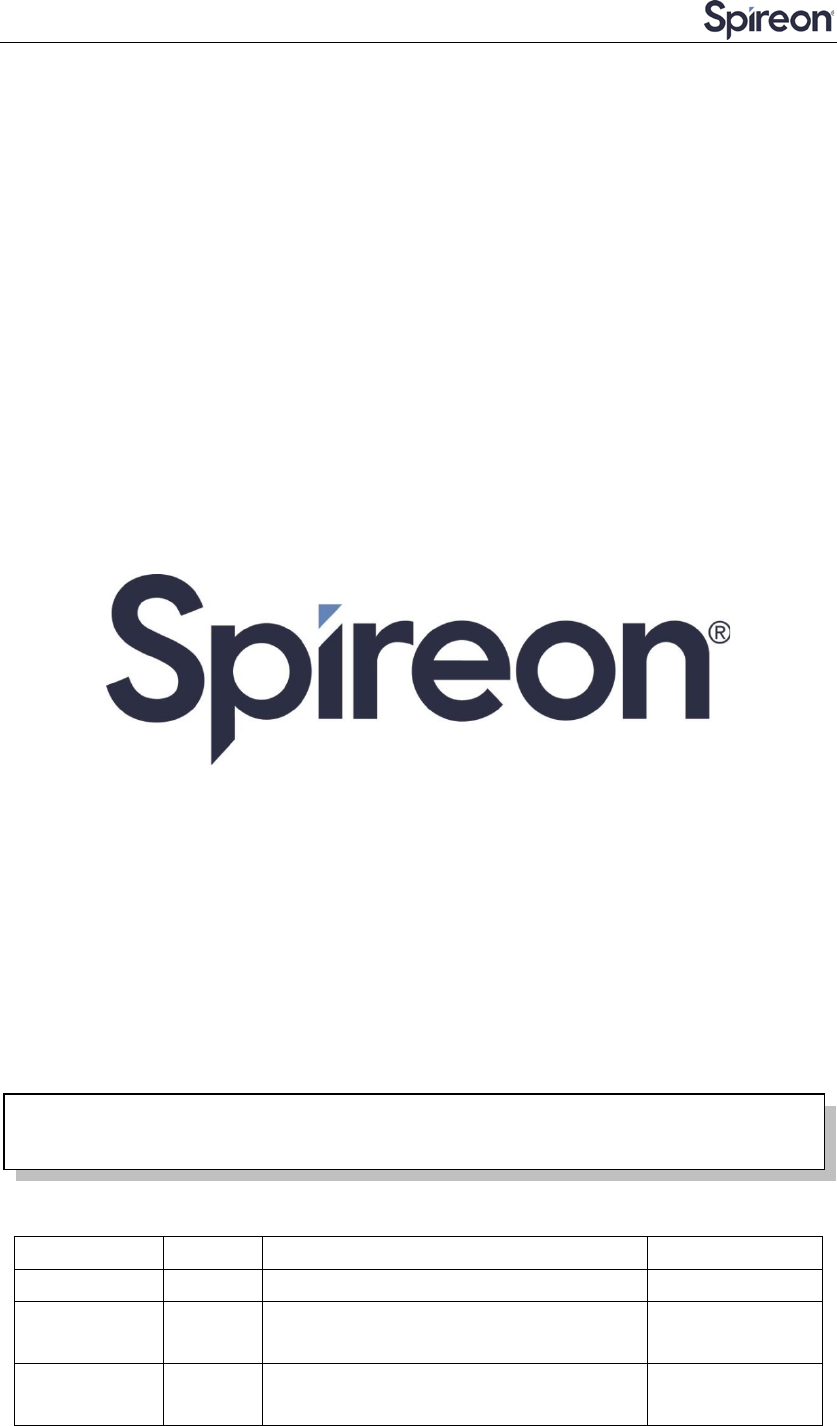
© 2018 Spireon, Inc.1 / 12
User Manual
For the
JG-LS/JG-L
Trailer Tracking Device
September 18, 2018
R1.2
Author Revision Changes Date
Ewing 1.1 Initial version 2018-09-18
The information presented in this document is strictly confidential and contains trade secrets
and other confidential information that are the exclusive property of Spireon Inc.
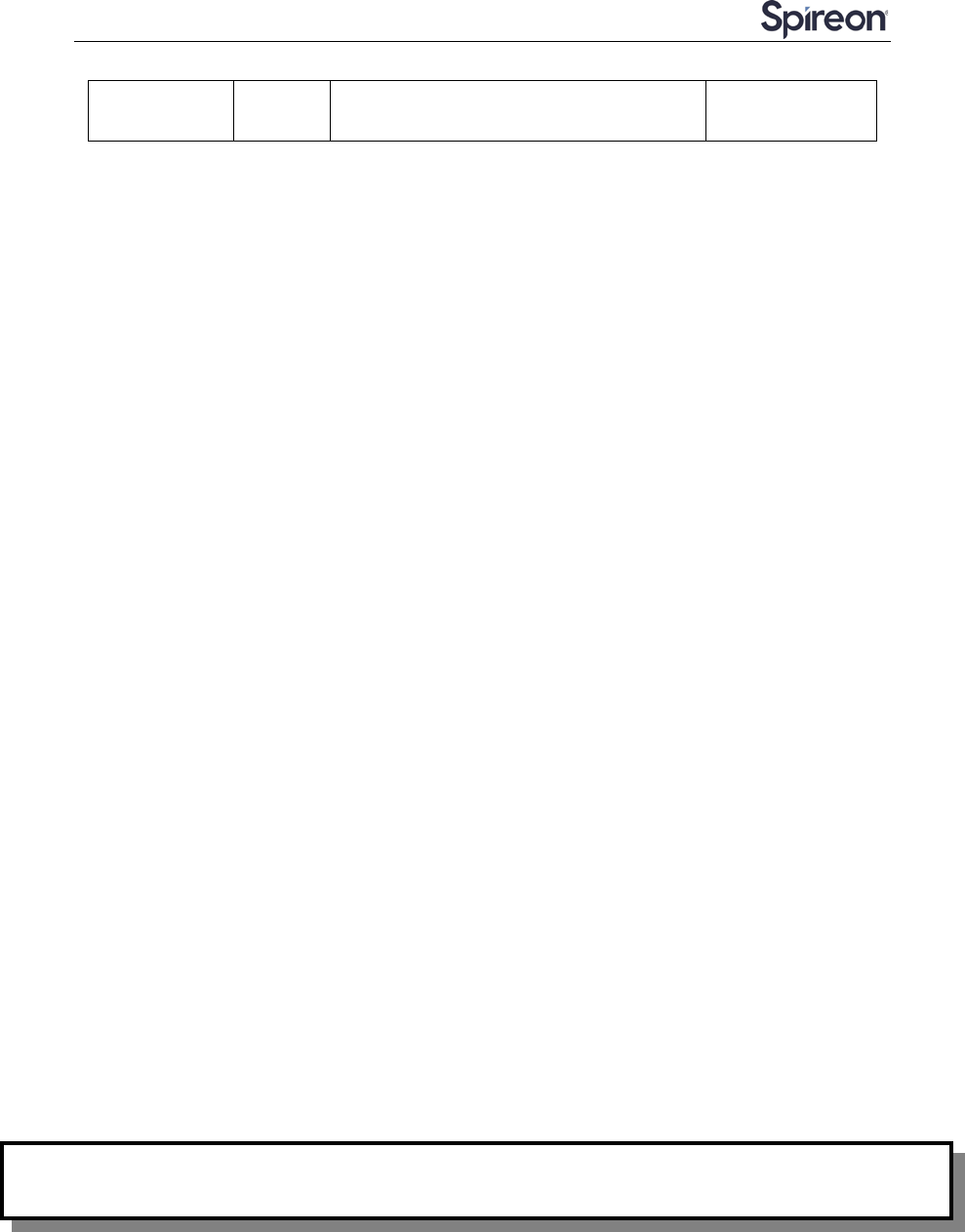
© 2018 Spireon, Inc.2 / 12
Contents
Introduction ....................................................................................................................................... 3
Hardware Design .............................................................................................................................. 4
Basic Hardware ............................................................................................................................. 4
Certification and Safety ................................................................................................................ 7
Software Features .............................................................................................................................. 7
Basic Software .............................................................................................................................. 7
Remote Update .............................................................................................................................. 8
Power Modes ................................................................................................................................ 8
Report ............................................................................................................................................ 8
Reset .............................................................................................................................................. 9
Context Preservation ................................................................................................................. 9
Startup Banner .............................................................................................................................. 9
Test Method .................................................................................................................................... 10
Hardware ..................................................................................................................................... 10
Software Test ............................................................................................................................... 10
Mechanical Structure(mm) ............................................................................................................. 11
FCC Statement ................................................................................................................................ 12
The information presented in this document is strictly confidential and contains trade secrets and other confidential information that are the
exclusive property of Connected Holdings

© 2018 Spireon, Inc.3 / 12
Introduction
The JG-LSis a self-contained LTE CAT1/3G wireless tracking device targeting trailers.
The device combines GPS location with LTE /WCDMA connectivity. It is primarily a
location reporting device that responds to requests (user, server) and events
generated by timers, geofences, sensors, etc. Data reports consist of a single
record that contains all location data and system status.
The device comes pre-configured and ready to use from the factory. The JG-LS
appears to a user or a server application as a single endpoint device. It can be
queried, updated and configured either through a serial connection, or an over the air
LTE or WCDMA IP connection, or through SMS messaging. The JG-L Spresents itself
over these connections as an enhanced cellular modem with attached functional
elements. These elements include:
GPS location engine
2 General Purpose Bidirectional I/O (GPIO) pins
1 Relay Output
1 Tamper
1 1-Wire Bus Interface
3.3V Power out for Peripheral Sensors
Serial UART port
Input voltages and Battery Voltage monitor
Timers
Watchdog lockup protection
Motion detection
Power Management
Access to these elements and general-purpose interfaces is done through an
extended AT command set. Configuration parameters are stored to flash memory
and are automatically used on the next power up event. For more details, please
reference the AT Command document.
This device is designed based on the Quectel EC21-A (4G LTE CAT 1/3G fallback,)
baseband module. Antennas for cellular and GPS are internal to the device.
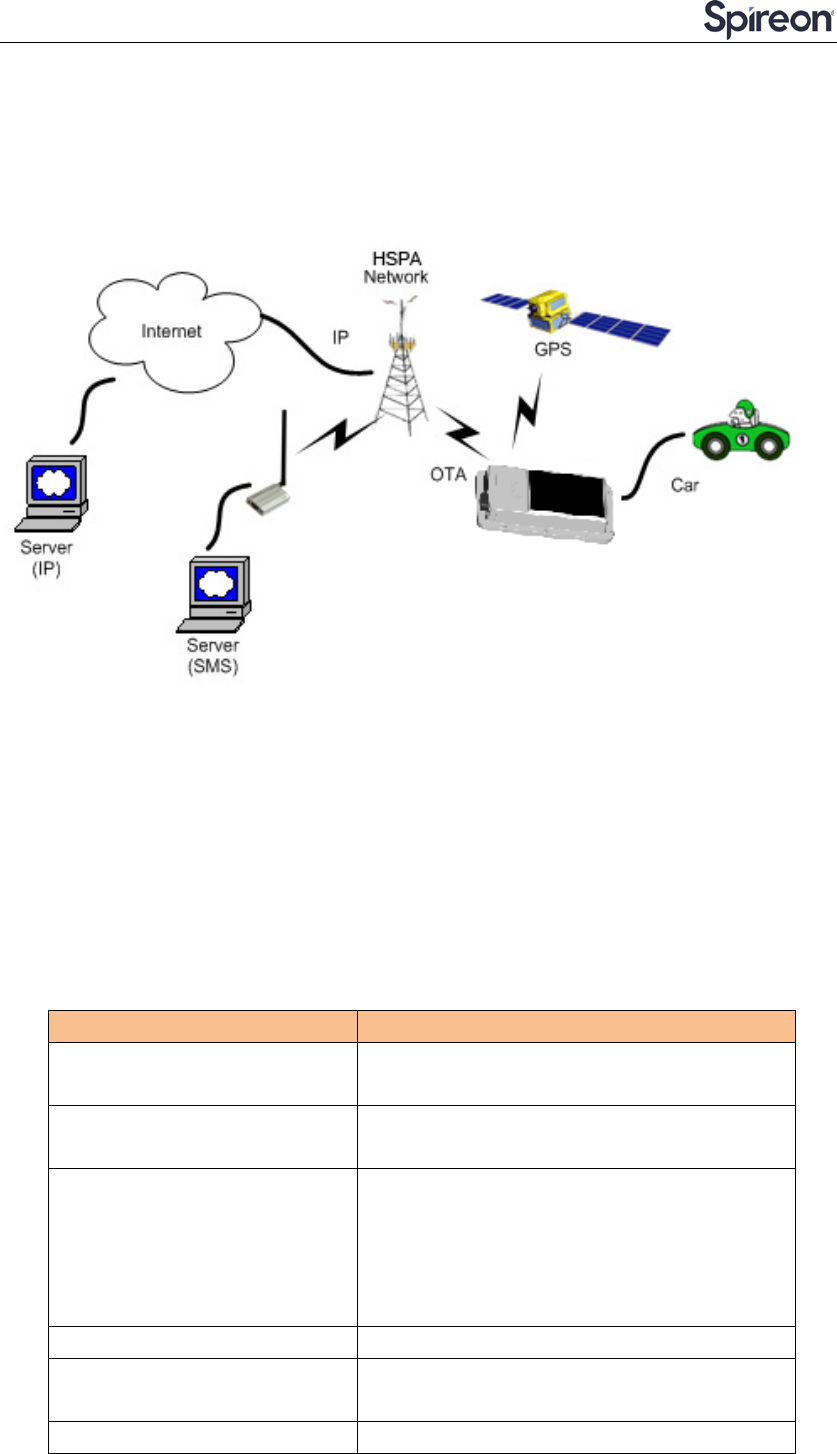
© 2018 Spireon, Inc.4 / 12
Diagram
The device also includes stand-alone GPS functionality, an accelerometer for motion
detection, as well as support for solar panel power supply. The JG-LS can operate
from an internal rechargeable battery or an external power source. The battery is
recharging via the solar panel or external power.
Hardware Design
Basic Hardware
Items
Requirement
Baseband Module Based on Quectel EC21-
A baseband
module
Air Interface
Support for LTE B12, B4, B2 WCDMA B2,
B4, B5
Frequency B2(MHZ):TX(1850-1910) RX(1930-1990)
B4(MHZ): TX(1710-1755)
RX(2110-2155) B12(MHZ): TX(699-716)
RX(729-746)
B5 (MHZ): TX (824-849) RX (869-894)
Antenna
integral antenna
UIM requirement Support: 3FF SIM interrupt mode
No Support: Hot plug/unplug
GPS Antenna
Dedicate high performance ceramic
JG-LS/
JG-L

© 2018 Spireon, Inc.5 / 12
antenna
Power Inputs 12V DC Input(1.7A max current)
Main/Aux/Solar inputs
Interface
Voltage/Battery Monitor
Build in battery manager
Dedicate Timers
UART TX/RX
GPIO1 and GPIO2
1-Wire Bus Interface
3.3V Power out
Internal analog input scaled
Watchdog
Supported
Motion Detect
GPS/G-Sensor
LED
3 LED’s (Red, Green, Orange)
Battery
Built in battery
(
4400mAh Lion
)
Working Time
> 40 hours (Continuously On)
> 250 days Standby
Power switch
No
Power Cable connector
type
23 pin
Power Consumption
< 5 Watts
The JG-LS provides support for specialized hardware features through extended AT
commands. The features supported include the following.
GPS
GPS location functionality is provided by the device GPS receiver. NMEA GPS
records can be extracted in real time from the unit via the UART connection using
special debug commands that are outside the scope of this document.
GPIO
Two general purpose GPIO and two additional multiplexed IO’s are presented to the
external environment on the main connector. They are capable of providing system
interrupts to generate a report or drive logic levels to external devices. These lines are
3.3V logic level and are 16V tolerant. The multiplexed IO’s are typically configured as
Ignition, Relay and Tamper.
LED’s
Three LED status indicators are provided to verify correct installation and operation.
The status LEDs are color coded and directly convey the status of the cellular and
GPS subsystems, as well as the power input; described in the table below. Their valid
operation also indicates operational status and power.
LED Function Status
Red GPS On: GPS satellites acquired and locked
Flash Slow: GPS satellite search is in progress
Off: GPS is turned off

© 2018 Spireon, Inc.6 / 12
Green Cellular
Connection
On: Indicates cellulardata connection is available
Flash Slow
: cellular subsystem initialized but no
connection
Flash Fast: cellular initialization in process
Off: Cellular sub-system is off
Orange
Battery
charging
On: Indicates external power and battery is fully
charged
Flash: Indicates external power and battery is charging
Off: Indicates running from battery. Blinks shortly every
30sec.
The JG-LS provides user control allowing the LEDs to be extinguished once
installation is verified. This feature reduces power and further conceals the JG-LS
Tracker from untrained parties wishing to defeat its operation.
Accelerometer
The accelerometer is used for motion start detection to wake the unit up from a sleep
mode and driving behavior monitoring.
UART
A UART port is provided for AT command and data interaction. The UART can also
serve to attach other accessories, such as cargo sensor.
1-Wire
A 1-Wire interface is supported to attach external sensors, such as temperature
sensor, etc.
Relay Driver
A 500mA sink capable output pin is provided. This pin is meant to drive a relay coil
indented to operate a door opening device.
Ignition Monitor
One of the GPIO’s can be wired to vehicle ignition to monitor and trigger event upon
ignition start and stop.
Power Out
The JG-L provides a power out option at 3.3V and up to 1A to enable powering up
external devices. The power out is turned off by default and is controlled by software.
Tamper
Tamper detection pin is available on the external connector. The Tamper pin can
trigger an alert when disconnected from ground.
Solar Panel
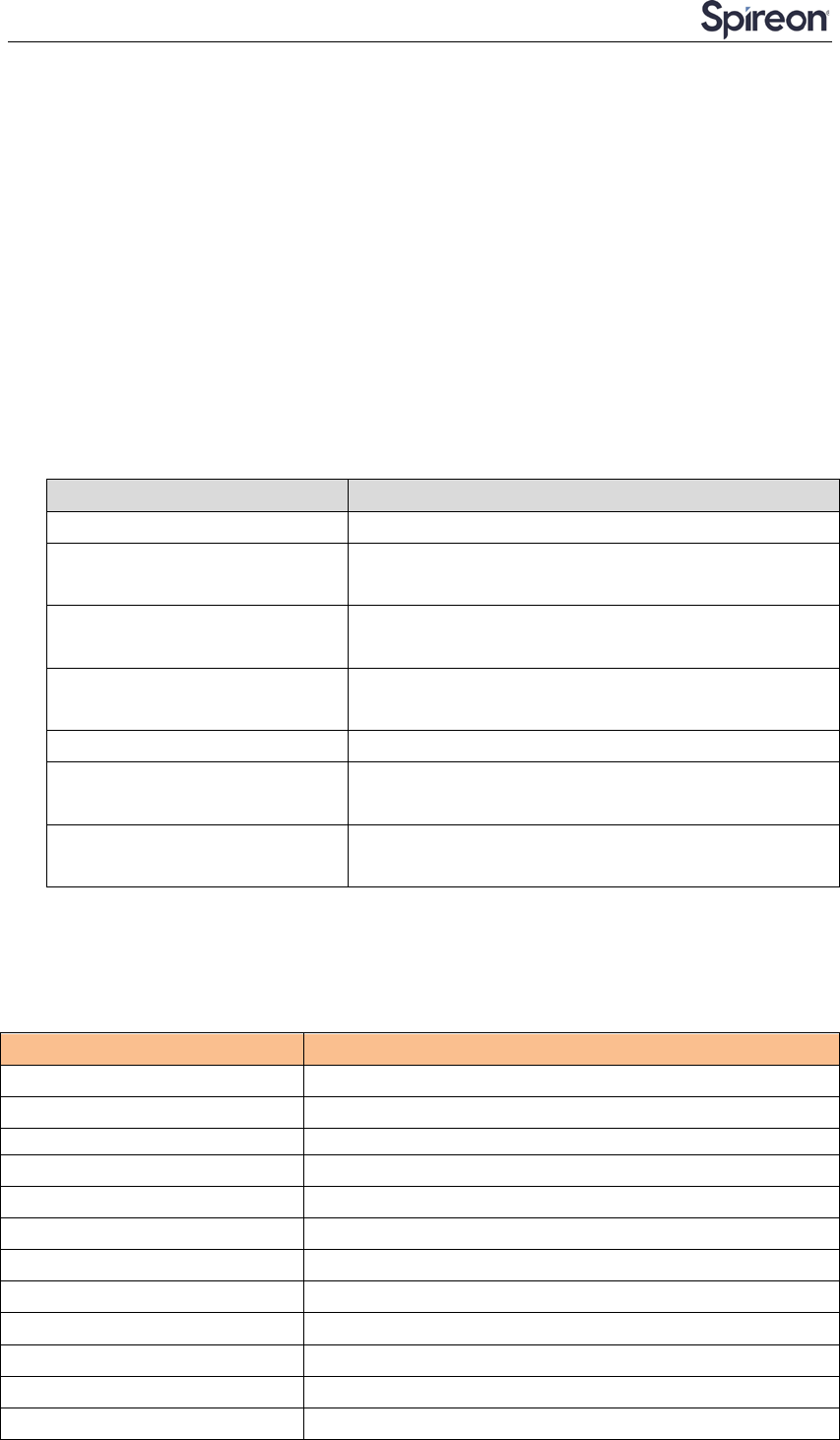
© 2018 Spireon, Inc.7 / 12
The JG-LS includes an integrated solar panel that constantly charges the battery
when exposed to light.
Power Monitor
The internal power monitor circuitry allows to measure the voltage on all possible
power sources: Main, Auxiliary, Battery, Solar.
Timers
Timers resident on the baseband chip generate periodic interrupts for power down,
wakeup, report generation and other timer related functions.
Certification and Safety
Items
Requirement
Drop Design
1meter 6 direction standard drop test
Temperature Range -20 to 65C Operation
-30 to +85° C Storage
Humidity: 30 % to 95% Operation
10% to 95% Storage
Vehicle ISO Test ISO7637-2-2004; ISO7637-3-2007;
ISO10605-2008; ISO16750-2-2010
FCC Certification
FCC 47 CFR Part 15,Part 2,Part 22,Part 24,Part 27
Others Operator
Requirement
Industry Canada/ AT&T (optional)
ESD Requirement Contact Discharge: +/-4KV Voltage
Air Discharge : +/-8KV Voltage
Software Features
Basic Software
Items
Requirement
Network Interface
CAT 1 LTE: B2, B4, B12, WCDMA: B2, B4, B5
IP Stack
Ipv4/IPV6
Upgrade Method
Remote update/ PC tool
Remote Update
Supported
Power Modes
Supported
AT Command
Supported
Report
Supported;3000 records
Driver
GPIO
,
LED
,
GPS
,
UART
,
3.3V out
GPIO
Interrupt for Door Open Detect
LEDs
GPS Status, Cellular Status, Power State
Watch Dog
Supported
Reset
Soft reset

© 2018 Spireon, Inc.8 / 12
Startup Banner
Supported
Remote Update
The JG-LSsupports OTA field upgrades of the JG-LSresident application. An over the
air TFTP (Trivial File Transfer Protocol) connection is made over a UDP/IP connection.
A replacement file is then transferred from a server to the JG-LSand that file replaces
the previous application image.
Power Modes
The JG-LS device supports several power modes that are set by AT commands. In full
power mode the GPS is active and the cellular subsystem will maintain a persistent
cellular connection whenever service is available. IP connection is maintained
according to the configuration of the device.
The device can be put in a sleep mode whenever it runs on an internal battery, if the
external battery is low or if the device is not moving. In low power mode the GPS is
not running and the LED’s are off. The device would return to full power whenever an
event occurs that triggers a report. Those events include:
• GPIO change
• Battery threshold
• Heartbeat
• Power-up
• Accelerometer
• Tamper
Any hardware or software reset will return the device to full power mode.
Report
The JG-LS captures data and forms a report record with that data. A report is a data
structure containing all of the sensory and other typically useful data on the device.
Reports are generated in response to specified events, such as periodic timeout,
speed threshold, geo-fence crossing, etc., or in response to a Report Now command.
Report Queuing
If a report trigger occurs while UDP connection is unavailable, it will be queued until
connection becomes available and transmitted at such time. The only way report(s)
can be lost is if too many reports are queued and the report-queue is overflowing. In
such case the earliest report(s) will be discarded. The size of the queue can be
configured via the Report Queue command.
Ack’ed Mode
UDP is not a 100% reliable connection and occasional reports or
command/responses may be lost. Since all commands have responses, the server
can repeat any command to which there is no response. In order to assure reliable

© 2018 Spireon, Inc.9 / 12
reception of reports, the device can be configured either in Normal or Ack’ed mode to
send the reports. In the Normal mode the reports are simply sent “as is” with no
acknowledgment from the server. In the Ack’ed mode every report sent is expected to
be acknowledged by the server by sending back an ACK message back. If
acknowledgement is not received within the specified timeout, the report is re-sent. If
the report is not acknowledged after the specified number of attempts, it is queued. If
acknowledgement is received after the report is queued (i.e. past timeout of the last
attempt), it is ignored.
Report is not considered “complete” until its acknowledgement is received. Thus, if
report X is sent and report X+1 is triggered while waiting for acknowledgement of X,
report X+1 will be queued until such acknowledgement is received and only then sent.
The JG-LS will attempt to re-send queued report(s) every time a new report is
triggered. If there is more than one report queued, the reports will attempt to be sent in
the order of triggering and only once the report is acknowledged, the next report is
attempted. This assures that reports are sent and received in order.
Ack’ed mode assures that all reports are received, but adds overhead in time and
data. Report that is not acknowledged is sent again and eventually will be queued and
sent again. The number and frequency of re-tries is configurable via the Report
Acknowledgement command.
Event Report Format
Reports are encoded as binary hex.
Reset
There are a number of resets available on the device. Soft reset only restarts the
baseband on the device. Hard reset is caused by resetting the whole baseband
module via a reset pin. There is also an option to reset the cellular and GPS
sub-systemsonly.
Context Preservation
When a self-initiated reset is performed due to Network Watchdog or by the Reset
command (modes 0,1), the context of the system is being preserved and is restored
after the reset. The context includes all the periodic timers, the report queue, the
odometer, etc. This allows to reset the unit as a troubleshooting or preventive
measure without losing reports that are already in the queue or are pending on
running timers. Note that the reset process may cause 1-2min of inaccuracy in the
timers and should not be considered as very precise.
Startup Banner
After a reset a startup banner is printed through the UART only.

© 2018 Spireon, Inc.10 / 12
Test Method
Hardware
Test Item
Description
Baseband Function Test • Power Input Test
• Power Consumption and Current Test
• Heat Dissipation Test
• UART Stability Test
• GPIO Level Test
• LED Stability Test
• Drop Down Test
• ESD Test
• High/Low Temperature Test
• Humidity Test
RF Test • RF Performance Test
• GPS Performance Test
• Antenna Performance Test
Software Test
Test Environment Construct
Message Test environment
1. USB dongle and PC as message server
2. Send message to JG-LS
UDP Test environment
1. Connect dongle to PC and create dialup as ip server
2. JG-LS create IP connection to server
UART Test environment
1. Connect JG-LS to pc with com serial cable
2. Open Terminal tool and send at command
3. Response can be shown at terminal window
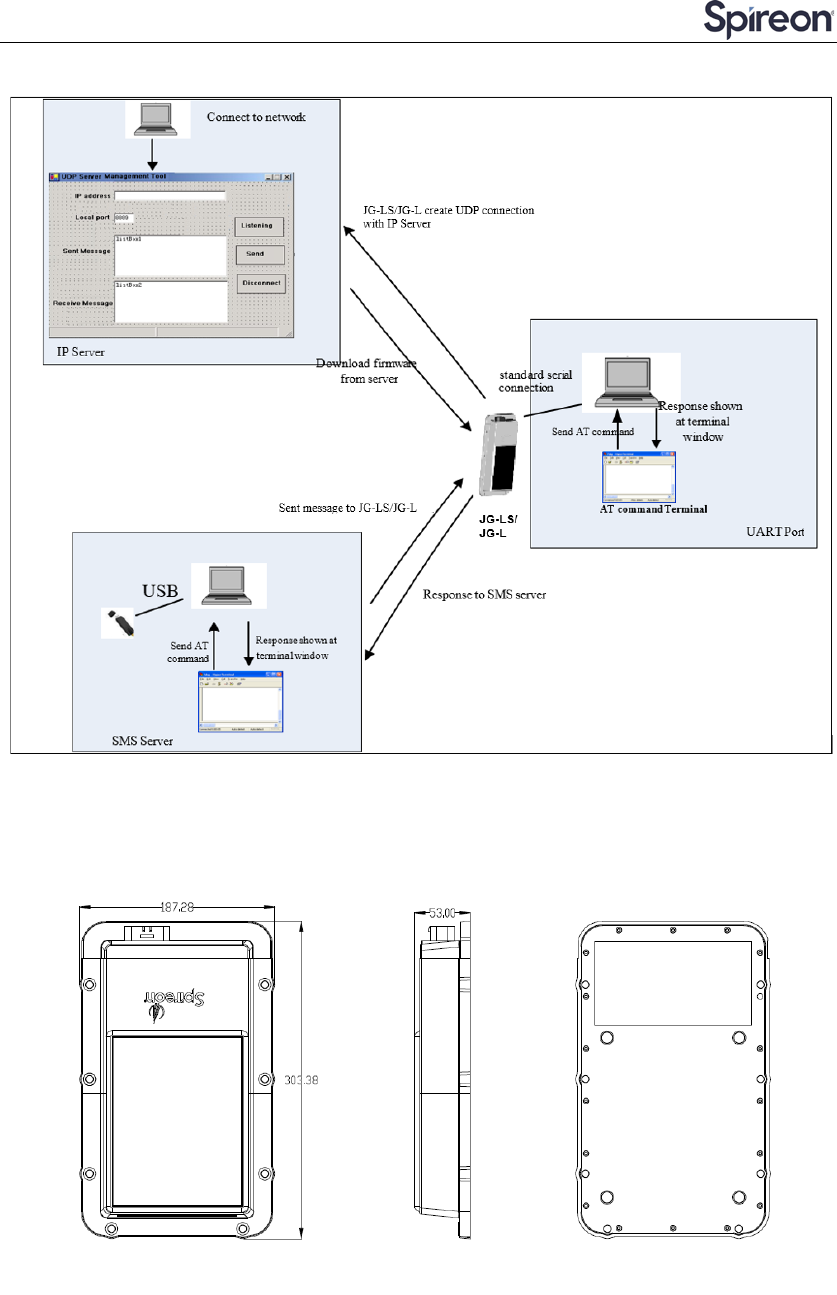
© 2018 Spireon, Inc.11 / 12
Mechanical Structure(mm)

© 2018 Spireon, Inc.12 / 12
FCC Statement
RF Exposure Warning Statements:
The antenna(s) used for this transmitter must be installed to provide a separation distance of at least 20
cm from all persons and must not be co-located or operating in conjunction with any other antenna or
transmitter.
This equipment has been tested and found to comply with the limits for a Class B digital device, pursuant
to Part 15 of the FCC Rules. These limits are designed to provide reasonable protection against harmful
interference in a residential installation. This equipment generates uses and can radiate radio frequency
energy and, if not installed and used in accordance with the instructions, may cause harmful interference
to radio communications. However, there is no guarantee that interference will not occur in a particular
installation. If this equipment does cause harmful interference to radio or television reception, which can
be determined by turning the equipment off and on, the user is encouraged to try to correct the
interference by one or more of the following measures:
-- Reorient or relocate the receiving antenna.
-- Increase the separation between the equipment and receiver.
-- Connect the equipment into an outlet on a circuit different from that to which the receiver is connected.
-- Consult the dealer or an experienced radio/TV technician for help.
Changes or modifications not expressly approved by the party responsible for compliance could void the
user's authority to operate the equipment.
This device complies with part 15 of the FCC Rules. Operation is subject to the following two conditions:
(1) This device may not cause harmful interference, and (2) this device must accept any interference
received, including interference that may cause undesired operation.
IC STATEMENT
This device complies with Industry Canada licence-exempt RSS standard(s). Operation is subject to the
following two conditions: (1) this device may not cause interference, and (2) this device must accept any
interference, including interference that may cause undesired operation of the device.
Le présentappareilestconforme aux CNR d'Industrie Canada applicables aux appareils radio exempts de
licence. L'exploitationestautorisée aux deux conditions suivantes : (1) l'appareil ne doit pas produire de
brouillage, et (2) l'utilisateur de l'appareildoit accepter tout brouillageradioélectriquesubi, mêmesi le
brouillageest susceptible d'encompromettre le fonctionnement.
In order to avoid the possibility of exceeding the IC radio frequency exposure limits, human proximity to
the antenna shall not be less than 20cm (8 inches) during normal operation.
Afind'éviter la possibilité de dépasser les limitesd'exposition aux fréquences radio de la IC CNR102, la
proximitéhumaine à l'antenne ne doit pas êtreinférieure à 20 cm (8 pouces) pendant le fonctionnement
normal.